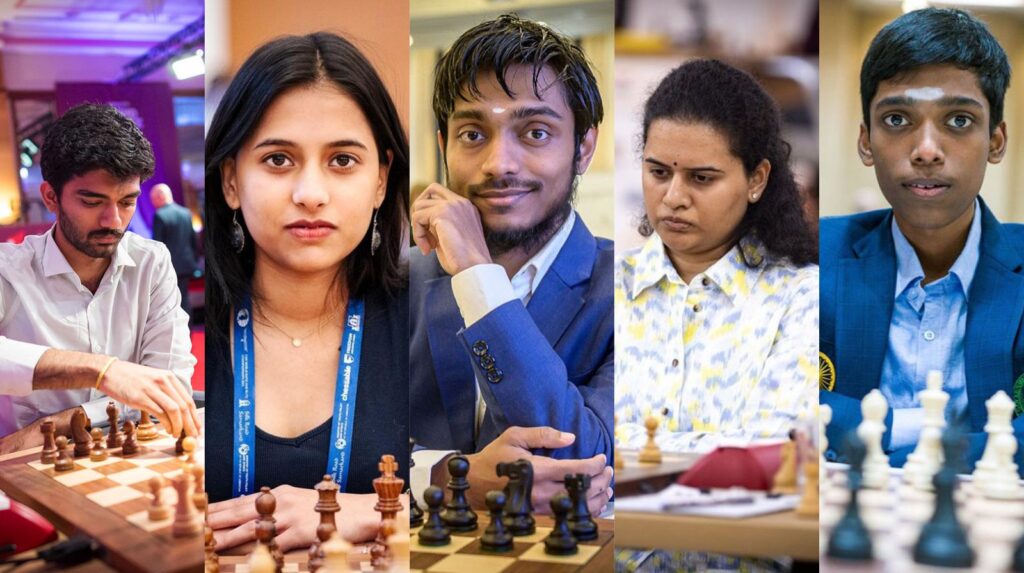
Atreyo Mukhopadhyay
The World Cup is a good reference point to study the phenomenal rise of India’s chess prodigies. In the 2023 edition of the biennial event in Azerbaijan, four Indians made it to the quarterfinals in the open section. R Praggnanandhaa finished runner-up. It was the first sign of the wave that subsequently saw players from the country win some of the biggest prizes on offer.
Zoom into the women’s World Cup 2025 being played in Georgia. Four Indians are in the quarterfinals for the first time. Divya Deshmukh has knocked out the world No. 6 and Koneru Humpy is turning the clock back. Allaying apprehensions that India’s progress in the women’s section is slower, they are collectively challenging the best. Not in as great numbers as the men, but they are also forming a group near the top end of the world rankings.
Long list of achievements
Sandwiched between these two World Cups are achievements with few parallels in the recent history of the game. It’s a long list, which includes D Gukesh winning the Candidates and World Championship, the men’s and women’s teams striking gold at the Olympiad, Arjun Erigaisi breaking the 2800 barrier in Elo ratings, four Indians in the top 10 of the world rankings, Pragg winning tournaments for fun and Humpy clinching the women’s world rapid title late last year.
Add Aravindh Chithambaram’s silent rise, eight Indians in the top 40 in the open section and four in the top 20 in women’s, V Pranav and Divya emerging the boys’ and girls’ U-20 world champions and Indians crowding the world cadet meet podium — one wastes no time to guess in which country this year is the International Chess Day (July 20, foundation day of FIDE) celebrated with maximum grandeur. Performance and potential, India is the most happening chess nation on several counts.
Garry Kasparov gave this phenomenon a decisive and new angle when he said last month that the Magnus Carlsen era is ending. The new crop led by Gukesh is ready to take over. Coming from the Russian legend, who mentored the Norwegian genius in his earlier days and helped him snatch the world crown from Viswanathan Anand in 2013, this was a milestone statement.
Bringing Carlsen down to earth
While Gukesh downplayed the compliment showing characteristic modesty, Carlsen has had a rough time dealing with the youngsters he was not previously impressed with. Gukesh beat him in classical and rapid and then Pragg handed the undisputed world No. 1 twin setbacks in freestyle — a format that Carlsen prefers over any other these days. He is even prepared to quit classical for this.
Beating Carlsen in three formats in a quick span ranks high among all the accolades won by this predominantly young crop. He was vocal in expressing his reservations against accepting the Indian ascendancy and missed no chance to talk them down until recently. Getting the better of him in four games doesn’t bring his empire down, but brings him down to earth to an extent.
Versatility, incentives and initiatives
The best part is versatility. Despite the conquests in classical, their speed chess record was not flattering. Having got a hang of it, Indians have started doing well in faster time controls. Gukesh not only defeated Carlsen in a rapid and blitz event in Croatia, he topped the rapid section and finished third overall. Pragg won three elite titles on tie-breakers. His sister Vaishali claimed the world blitz bronze. Erigaisi became the first Indian to reach the semi-finals of a freestyle Grand Prix.
Quickly expanding infrastructure under private patronage, the All India Chess Federation introducing quarterly stipends for promising players from the U-7 to U-19 levels, players getting more and more sponsors and the number of role models multiplying — these are some of the factors that will drive this surge. The level of coaching has improved by leaps and bounds following the involvement of highly-rated Grandmasters. Given this backdrop and growing interest, there is more in store.
Follow Revsportz for latest sports news